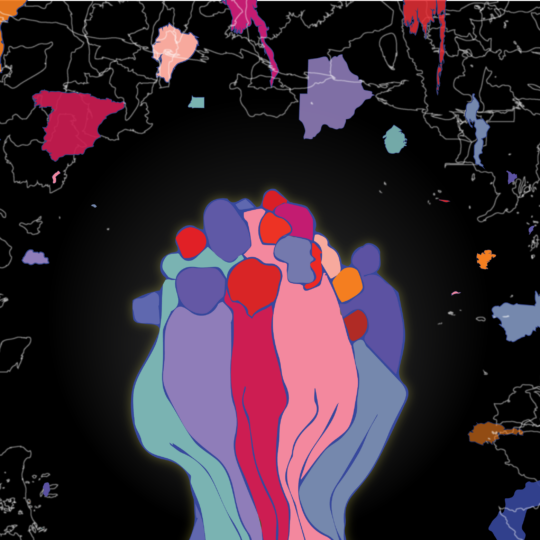| 16 Apr 2018 - 17 Apr 2018 | 9:00am | SG1 Alison Richard Building, Sidwick Site | |
- Description
- Programme
- Abstracts
Description
Online booking for this event is now open. Please click here or use the online registration link on this page. There is a standard fee of £10 to attend the whole event, including refreshments and lunch. If you only wish to attend the keynote lectures these are free to attend but booking is still required. Please click on the programme tab to see the full programme.
Convener: Dr Trenholme Junghans (Limits of the Numerical Project, CRASSH, University of Cambridge)
Crosscurrents of Commensuration will explore commensuration – in its widest possible sense – as a focus of critical analysis across the social sciences and humanities. Construed broadly, commensuration involves equating units or entities judged in the first instance to be essentially different and incomparable with one another. Such operations of same-making – along with corollary processes of differentiation and distinction – are fundamentally generative aspects of sociocultural life, and have proven to be highly fecund as both objects and optics of analysis across the social sciences and humanities.
This two-day event will bring together researchers from across the social sciences and humanities to consider commensuration from different disciplinary and theoretical perspectives with the aim of broadening and deepening the critical scope of commensuration as an optic of social analysis. What arises at the intersection of different ways of thinking about commensuration and its cognates? How might different disciplinary approaches to commensuration and cognate problematics enrich and inform one another?
One influential strand of social scientific thinking has considered commensuration in terms of processes of quantification, abstraction, and commodification associated with the spread of market capitalism and with practices of rationalization and standardization characteristic of “modern” state power. More recent sociological work has taken up commensuration in relation to the proliferating use of metrics, indicators, and rankings associated with audit cultures and regimes of neoliberal governance more generally. Work in this vein attends to these devices’ formal properties and situated uses to illuminate how they are apt to effect subjects’ conduct and to generate new entities. Recent anthropological work has extended the concept of commensuration beyond literal measurement and the explicitly quantitative to consider how claims and pragmatic enactments concerning degrees of likeness, difference, and relative value are generative of all manner of sociocultural bridges and boundaries. This work also calls attention to the contingent nature of commensuration – to the work of comparison and judgment it entails, and to the fact that it is subject to authoritative ratification, and liable to contestation, subversion, and failure.
Social science approaches to commensuration overlap in suggestive ways with work in other disciplines on translation as a project of marking, mediating, and managing boundaries of all types: linguistic, cultural, spatial, and temporal. How, for example, does a Christian missionary translate scripture such that it is sufficiently recognizable to be embraced by those whom he would convert, and yet also sufficiently distinct that its embrace can be considered a true “conversion”? When is a translation of any type considered “true” to the original, and how does a copy – be it of a text, a material document, or of a pharmaceutical product – become a fake? What interpretive codes and semiotic ideologies underpin such determinations, and how are they, too, negotiated and contested in tandem with reckonings of identity and difference?
Crossroads of Commensuration will bring together researchers to explore commensuration and its cognates as variously problematized within different disciplines and in relation to different objects. We invite proposals for 20-minute papers from researchers working on commensuration and its cognates from different disciplinary and theoretical perspectives.
Keynote Speakers :
Professor Wendy Espeland (Northwestern University)
Professor Brackette Williams (University of Arizona)
For administratie enquiries please email Michelle Maciejewska.
Sponsors
Crosscurrents of Commensuration is sponsored by the Limits of Numerical research group at CRASSH, University of Cambridge, with generous support from the Independent Social Research Foundation (ISRF).

Programme
| Monday 16 April 9.00-9.30 | Registration and coffee |
| 9.30-9.45 | Welcome |
| 9.45-11.15 | Panel 1 Stefan Ecks (University of Edinburgh) Călin Cotoi, Cosima Rughiniș (University of Bucharest) and Sorine Vasile (Clinical Emergency Hospital Bucharest) Stavroula Pipyrou (University of St. Andrews) |
| 11.15-11.45 | Tea/coffee break |
| 11.45-13.15 | Panel 2 Ben Epstein (University College London) Cristiana Bastos (University of Lisbon) Ahmad Moradi (University of Manchester) |
| 13.15-14.00 | Lunch |
| 14.00-15.30 | Panel 3 Emily Finer (University of St. Andrews) Bethany Dubow (University of Cambridge) Siddharth Pandey (University of Cambridge) |
| 15.30-16.00 | Tea/coffee break |
| 16.00-17.15 | Keynote lecture: Wendy Espeland (Northwestern University) |
| 17.15 | Drinks reception |
| Tuesday 17 April 10.00-11.15 | Keynote lecture: Brackette Williams (University of Arizona) |
| 11.15-11.45 | Tea/coffee break |
| 11.45-13.15 | Panel 1 Ikuno Naka (University of Oxford) Nurit Bird-David (University of Haifa) Tord Larsen (Norwegian University of Science and Technology) |
| 13.15-14.00 | Lunch |
| 14.00-15.30 | Panel 2 Marie Louise Herzfeld-Schild (University of Cologne) Lukas Engelmann (University of Edinburgh) Aleena Chia (University of Jyväskylä, Finland) |
| 15.30-15.45 | Tea/coffee break |
| 15.45-16.30 | Concluding discussion |
Abstracts
Cristiana Bastos
University of Lisbon
Cristiana.Bastos@ics.ulisboa.pt bastoscristiana@gmail.com
Child Mortality, Migrant Communities, and the Search for Commensuration in the Social Sciences
In this paper I will use the angle of commensuration as a means to approach the work of early 20th century U.S. social scientists. I will discuss their combined and competing efforts to measure, assess, interpret and fix social problems in contexts of migrant urban communities. I will focus on their discussions of health and infant mortality, their uses of race, their euphemisms for social class, and the different paths followed by anthropologists and sociologists of different schools. I will anchor the discussion on three empirical settings: (a) one detailed statistic-based sociological study of the conditions of child mortality in 1920 industrial Fall River, Massachusetts; (b) my current research on life and death on board of migrant vessels in the Atlantic and the Pacific at the turn of the 19th-20th centuries; (c) the ubiquitous discussion in anthropology and beyond regarding the management of child mortality in contexts of extreme vulnerability.
Nurit Bird-David
University of Haifa
nbird@soc.haifa.ac.il
“One, Two, Many”: Indigenous Perspectives on In/commensuration
Cultural anthropologists have yet to theorize why many indigenous languages lack words for high numbers, a phenomenon left today to the purview of cognitive linguists. Perhaps, they have wanted to evade the condescending popular stereotype of tribal people counting “one”, “two,” (then moving directly to) “many.” However, not addressing it only leaves this trope undisturbed. Moreover, I contend that this overlooked phenomenon offers cultural anthropologists a productive prism on indigenous ontologies/epistemologies, which currently draw much interest within and beyond the discipline.
Engaging the phenomenon dubbed by cognitive linguists “'one, two, many' counting systems” (Pinker 2007), in this workshop I propose to argue that it expresses indigenous resistance to commensuration. Furthermore, incommensuration underscores indigenous understanding and ways of figuring their world, especially but not only issues of “being one” and “being many.” Drawing on hunter-gatherer ethnography, I distinguish between two modes of “being many,” the first based on scalable same-making and serializing practices, while the second on unscalable relation-making as the basis of heterogeneous communities of humans and nonhumans. I examine how these kinds of manyness articulate as intimate hunter-gatherer communities are bureaucratically integrated as citizens of large-scale nation states. Attentive to indigenous own scales of practice and imaginations (following recent work in which I argued that their neglect for many decades has skewed understanding of indigenous cultures and ontologies, Bird-David 2017a, b), through this multiscalar case I look at the dialectics of quantification and qualification, and the dialectics of commensuration and incommensuration.
Aleena Chia
University of Jyväskylä, Finland
aleenachia@gmail.com
The Morality of Commensurability in Gaming Participation
Collective gaming practices in nonprofit hobby societies require meticulous coordination of volunteer labour through informal administrative infrastructures. This paper investigates the organisation of live-action role-playing (larp), which is undertaken improvisationally face-to-face using narrative guidelines and game rules that are synchronised over several years and across geographically dispersed divisions. Volunteers are incentivised by play rewards within the game in exchange for logistical and creative tasks performed within the club. Most achievement systems within digital gaming platforms are ancillary layers providing restricted cosmetic rewards to keep players engaged without compromising the goals and mechanisms of its core gaming products. In contrast, larp achievement systems trade-off the mechanical and narrative coherence of their games by making volunteer labour exchangeable for play advantages. Even though the standards of a good volunteer differed from those of a good player, these distinct resources were pooled separately and made commensurable across the boundary between hobby societies and its games. Players debated the principles and pragmatics of this commensurability and how it undermined the integrity of larp and its craft. As people moved between play and organisational activities, they continually negotiated the logics and limits of this commensurability between their contributions to each other – to what I call their participatory commons: discrete pools of resources collectively managed to take part in media culture. Charting the commensurability of participatory commons challenges arguments about the simultaneity and incommensurability of subcultural, reputational, and commercial systems in media participation, and suggests how value is distributed in multidimensional contexts, according to competing principles such as game rules, organisational needs, community norms, and aesthetic goals. This study is based on 18 months of multi-sited ethnographic fieldwork at game sessions, meetings, and conventions in Boston, Los Angeles, and Atlanta, and includes 20 in-depth player interviews.
Călin Cotoi
University of Bucharest
calin.cotoi@sas.unibuc.ro
Cosima Rughiniș
University of Bucharest
cosima.rughinis@sas.unibuc.ro
Sorina Vasile
Clinical Emergency Hospital Bucharest
sorina.vasile@gmail.com
The Vaccine-damaged Child: Contested Practices of Commensuration and Quantification
Opposition to vaccines is grounded in bodies of knowledge that recruit biological and medical knowledge, articulating it with other types of knowledge, such as concepts from homeopathy and holistic therapies, and personal experiences of vaccine damage, in communities of hybrid expertise involving medical practitioners, parents, journalists, public figures and other voices.
The construct of the vaccine-damaged child is an essential element that makes possible the articulation and accumulation of evidence of harm in the anti-vaccination bodies of knowledge, across different types of vaccines and imputed damage. At the same time, the vaccine-damaged child is all but invisible in the biomedical discourse, dissipated into a series of unrelated improbable coincidences through the lens of scientific medical research.
We discuss the use of alternative methods of commensuration and quantification in assembling the constructs of “vaccine-damaged child” and “evidence of harm”, and dis-assembling them, respectively, in competing discourses against or in favour of vaccination. We will examine contested practices of listing and counting, correlating or denying correlations through narratives and statistics, and quantifying toxicity in alternative discourses such as “the dose makes the poison”, “trace amounts”, and homeopathic “potentization” through dilution and succussion.
Empirically, we focus on the public debate accompanying a recent mandatory vaccination legislative proposal in Romania, occasioned by the 2016-2017 measles epidemic that led to 38 deaths to date, from 10749 reported cases throughout the country. This case study illustrates how global discourses on vaccination are translated by local actors and re-assembled in locally relevant and actionable forms of knowledge. It also offers the chance to observe how hybrid expert networks make visible instances of measles-related or vaccine-related harm, render them similar or dissimilar, count and interpret them in alternative accounts of the epidemic.
Bethany Dubow
University of Cambridge
bd351@cam.ac.uk
‘And the Scripture witnesses, that the world was made in number, weight, and measure; which are all the qualities of a good poem’: Numerosity and Poetry in Early Modern England
In my titular quotation, Abraham Cowley’s elaboration of an Augustinian maxim brings into focus an episteme which served to shape the broader stream of sixteenth-century cosmological and theological thought; namely, the belief that the universe could be described according to a transcendental law of number. The idea of a rational and mathematical cosmos originated in Pythagorean and Platonic metaphysics, but was reinterpreted by early Christian theologians, and afterwards by the humanists of Renaissance Italy. Broadly speaking, the poets and thinkers of Renaissance England held in common a vision of the cosmos as a closed inertial system; a divinely created monad in which correspondent elements take their place in a harmonious, hierarchical order, and in which local change is governed by the timeless law of number.
Accordingly, it was the job of the good Christian poet to translate the consummate proportions of God’s design into a poetic microcosm, and this for the education and enlightenment of his pious reader. As Cowley’s quotation implies, number was understood to be the dividing line between cosmos and chaos, order and disorder (for so it was when ‘God made a division betwene the light and darknesse’); thus, to identify ‘number’, ‘measure’ or ‘proportion’ in a poem was to assert one’s faith in its overarching logic and order, as one asserts one’s faith in the ultimate harmony of God’s design. These exercises were aided by the shared language of Renaissance poetics and geometry – to this day, we will limn the proportion of a line, consider stanzaic division or multiplication, notice how, as George Puttenham writes, ‘metres being by good symmetry [are] reduced into certain geometrical figures’.
Against such a backdrop, this paper explores the ethical and theological investment made by early modern poets in the overlap between mathematical and poetic vocabularies. However, it also hopes to draw attention to the ideology which enforces this overlap and perhaps suppresses other ways of understanding poetic form. What kind of world is created, for example, when an early modern poem exceeds conventional notions of proportion, or resists our efforts to subject its formal properties to quantification?
Stefan Ecks
Social Anthropology, University of Edinburgh
Stefan.ecks@ed.ac.uk
“Global Mental Health”: A Short History of Commensurations (and Their Failures)
Global Mental Health (GMH) is a systematic attempt at the full commensuration of diagnostics and care for mental illness from the global North to the global South. GMH is all about “scaling up” interventions from rich countries to poor countries. In the process of making different countries commensurable to each other, GMH has hit a series of obstacles. For example, there may be some trained psychiatrists and psychologists in poorer countries, but there are not nearly enough of them, hence the idea to “taskshift” by drawing on untrained health workers instead. While these untrained workers would never be fully commensurate to trained workers, they are meant to be “commensurate enough.” Northern psychiatry's diagnostic categories themselves have now emerged as a serious obstacle to global commensurations of care because they are “too specific.” This is leading to the development of “transdiagnostics” that try to identify common elements of all mental illnesses. This is an attempt at achieving commensuration by broadening the tertium comparationis that make mental disorders comparable to each other. In my paper, I will show that GMH policies are a fascinating case study in what happens when institutions strive to achieve global commensuration but fail to do so with the criteria of successful commensuration they set out at the beginning.
Lukas Engelmann
University of Edinburgh
lukas.engelmann@ed.ac.uk
The ‘Danysz Virus’ and the Making of an Early Model Epidemic
Jean Danysz, a polish bacteriologist at the Institute Pasteur in Paris established in 1892 a research program on the coordinated use of bacteria against rodents in French agriculture. Danysz’ question was: how to utilise bacteria to control the populations of voles and mice? But the larger, underlying question that he and his fellow Pasteurians grappled with was how to make an epidemic? After all, having identified and established bacteria as a necessary cause for many diseases in the laboratory did not explain the regular dynamics, the repeating rhythms and the characteristic spatiotemporal patterns of known epidemics.
In his experimental fieldwork, Danysz aimed first to determine the conditions under which the distribution of an infectious agent leads to epidemic outbreaks. A successful biological form of pest-control, the ‘Danysz Virus’, required a thorough understanding of the factors impacting on what he assumed to be the virulence of bacteria. As he studied the cyclic occurrence of epidemics among voles, Danysz developed eventually a conceptual commensuration between population-dynamics of voles and the bacteria’s virulence. The capacity of the infectious agent to ignite epidemic outbreaks, he argued, must be seen in a reciprocal relationship to its principal host population. The pathogenicity of bacteria to an organism seem to be mirrored by the organisms’ pathogenicity to the bacteria. This lead in turn to cyclic occurrences of population growth and epidemic outbreaks.
My paper will present Danysz’s experimental alignment of infectious agents and host species as an early and often overlooked attempt of formalising standardised epidemic distribution. This perspective will emphasize a theoretical commitment of the beginnings of epidemiological modelling to concepts of symbiosis and homeostasis.
Ben Epstein
University College London
ben.epstein@ucl.ac.uk
Commensuration as Groundwork: Ethnographic Reflections on Mental Health and Psychosocial Support Interventions After the Great East Japan Earthquake
This paper draws on research exploring the expansion of mental health and psychosocial support (MHPSS) interventions in the disaster-affected regions of northern Tohoku in the aftermath of the Great East Japan Earthquake. Focusing on the normative (value-laden) aspects of practitioner understanding and explanations, this paper addresses how lived experiences of tragedy, in the context of multiple and simultaneous catastrophes, are made commensurable in relation to the specificity of individual suffering.
MHPSS interventions promoted by numerous governmental and non-governmental actors are grounded on epidemiological data drawn from vastly different spatial-temporal contexts; producing homogenous groups, ‘subjects’ in need of aid, and the equivalence of ‘traumatic events.’ Tautologically, ‘support’ for disaster-affected communities is both the end and the means of interventions. Critics warn psychosocial programmes falsely assume that emotional processing with therapeutic support is a universally held value. Humanitarian mental health activities and psychosocial programming are described as homogenising, pathologising, controlling and depoliticising for victims and survivors (Rehberg 2014; Pupavac 2001, 2005). These, in turn, posit populations as uniform and predictably susceptible to emotional distress. For clinicians, inserting diagnostic criteria into novel terrains produces a common language intelligible across domains irrespective of the existing social or cultural situation. It then becomes germane to see the work of practitioners as an interplay of complex, partial truths. ‘Commensuration, as a mechanism that simplifies information and decontextualizes knowledge, both creates and obscures the relations among entities’ (Esepeland & Sauder 2007), making the claims of practitioners difficult to assess without treating knowledge practices involved in disaster mental health as performative of the categories themselves. Methods could be said to enact realities as well as describing them: when context forms the basis for intervention, it is turned into study sets, fungible data, and eventually loops back into the clinical knowledge-base and made a general feature of clinical practice.
Wendy Espeland
Northwestern University
wendyespeland@gmail.com
The History of 10%: Commensuration and the Politics of Gay Identities
Commensuration – the transforming of qualities into quantities that share a metric – is a fundamental way of making sense of the world. We commensurate when we standardize test scores, vote, attach prices to things, or conduct a census. The practice of commensuration can have important implications for how we understand who we are and who we are not, for our cultural and political identities. My paper examines the role that commensuration played in producing a particular identity that fused the cultural and the political: the identity of homosexuals as a minority group with a distinctive culture that required recognition, rights and protection. Social scientists, in their efforts to measure sexual behavior with surveys and interviews, played an important role in the origins of the modern gay rights movement and in the development of gay and lesbian identity politics. Measures, and critiques of measures, of sexual practice prompted the creation of the first gay rights organization in the U.S. They shaped how participants in an emerging political movement understood themselves, how and when they organized, and the political strategies they and their opponents uses. The commensuration of sexual practices in the U.S. helped forge a durable gay identity that gave rise to particular form of politics that evolved and was adapted over almost forty years.
Emily Finer
University of St. Andrews
ef50@st-andrews.ac.uk
Shorter and Better in Russian? Comparing Translations of “Our Mutual Friend” by Charles Dickens.
When translation theory addresses gain and loss, it usually refers to the accuracy, effect or quality of a translation in comparison to its source text. However, anyone who has worked as a translator, or attempted to word process bilingual teaching materials, will be acutely aware of quantitative differences. In the case of English to Russian translation, the Russian version will have fewer words than the original English text but – because those words will be longer – it will take up more space. In this paper, I address the commensurability of different translations of the same literary source text. Long-lasting enthusiasm for the novels of Charles Dickens in Russia and the Soviet Union means that multiple Russian translations of each of his novels are available; at least five translations of “Our Mutual Friend” were published between 1864 and 1962. Each translation is a different length and divided variously into instalments, parts, or volumes. Each translator has their own response to the challenge of reproducing Dickens’s use of individualised speech traits to differentiate between characters, classes, and locations. Whereas English readers are largely stuck with the original text, the language of each new Russian translation has modernised, or ‘caught up’ with its readers. While these differences could significantly affect the reading process and reception of the novel, there is also an intriguing possibility that they are overlooked in favour of the consistent plot and famous author, with the result that very different translations are, in fact, perceived as commensurable.
Marie Louise Herzfeld-Schild
University of Cologne
mherzfel@uni-koeln.de
The (In)Commensurability of Music and Emotions. An Historical Perspective
“Music sounds the way emotions feel”. This famous sentence by music psychologist Caroll C. Pratt offers an apparently clear answer to many questions – Why and how does music work emotionally? What kinds of emotions are triggered by what kind of music? And how are material sound waves in the air related to immaterial feelings within the soul? – and, in doing so, it seems to perfectly summarise the output of a discussion that has been going on for several centuries.
Pratt's sentence, however, suggests an isomorphism – or at least a similarity – between musical sound and felt emotion that is only apparent on first view. It is in fact rather unclear whether these two different things, music and emotions, are actually commensurable at all. The first is a sounding, the last a non-sounding thing. Both are sensual and perceived phenomena, and they are obviously closely related to one another, but what is the role of the human being that listens, feels, and perceives music and emotions respectively? And how can we actually best approach the question of commensurability (or incommensurability) between music and emotions?
In a first part of my paper I will test the commensurability of music and emotions by means of proportionality on an abstract level and ask what exactly can be measured and compared in the obviously problematic relationship between music and emotions. In a second step, I will introduce some solutions to the problem that have been proposed by doctors, philosophers and psychologists since the middle of the 18th century in order to give an historical perspective on how human thought has addressed the commensurability of music and emotions over time.”
Tord Larsen
Norwegian University of Science and Technology
tord.larsen@ntnu.no
Moralities of Subsumption
Commensuration has several cognates: classification, categorization, comparison, quantification, measurement, subsumption. In my presentation I will examine some contemporary forms of subsumption and bring to light the normative assumptions and political implications they carry with them.
The argument will be modelled on what I elsewhere have called “the morality of signs” – the notion that tropes and rhetorical figures have moral counterparts which sometimes go unnoticed. Metaphor may be seen as the trope of reconciliation, or of conquest and appropriation, metonymy as the maker of equivalents, synecdoche as the trope of hierarchy etc. Even “laws of logic” can be redescribed in a moral vocabulary. The moral equivalent of “the law of contradiction” is a promise ; in subscribing to it, I promise to be the same person tomorrow as I am today.
Students of quantification, commensuration and “the culture of indicators” have made similar claims for practices of quantification, pointing out the performative and generative nature of counting and measurement, heralding an “ethics of quantification” (Espeland), analyzing statistics as an instrument of domination, seeing enumerative modalities of investigation as “epistemic violence” (Cohn), underlining the inventive capacity of categories (Hacking, Ruppert).
After a brief historical survey of “subsumption” – from Kant’s ahistorical, amoral use of the term to describe the synthetisization of the manifold by the categories of understanding, to the historical and political slant which Hegel and Marx bring to the concept – I identify a number of predominant classes under which contemporary practices are subsumed: possessibles (like forms of capital), pathologies, a list of reified mental contents, heritage.
I will pay particular attention to forms of self-objectification performed in varieties of identity politics. Objectification of culture is sometimes described as making cultural premises explicit, a strategy of representation which sometimes fails to recognize the transformation cultural elements and practices undergo as they are subsumed under current schemes of classification.
Stavroula Pipyrou
University of St. Andrews
sp78@st-andrews.ac.uk
First-sight: (In)Commensurability and the Vicissitudes of Belonging
In this paper I argue that the historical project of nationalism has been premised on what I call “first-sight belonging”; the first un-reflexive encounter with the Other and their irreducible commonality. I look at two distinct groups – second-generation Pontian refugees in Greece and the Greek linguistic minority in South Italy – to interrogate the manner that carefully orchestrated frameworks of commonality are built between a nation and groups thought to be its extended parts. Based on language, kinship, and blood, these frameworks operate as sites of “first-sight belonging”. When the Other is 'exposed' through speech or performance, incommensurability creeps-in and the dream of common belonging is seriously jeopardised. Civil society takes over the restorative project to create commensurable embodiments and patterns of cultural enactment between groups so that the grand narrative of commonality appears narrativistically and performatively convincing.
Ahmad Moradi
University of Manchester
ahmad.moradi@manchester.ac.uk
The Perils of Commensuration: Virtue and Value of Sacrifice in Iran
To recompense losses incurred during the Iran-Iraq war (1981-1989) has proven to be a major meeting point between war veterans and the state in Iran, as well as a source of political contestation within the population of veterans. Inasmuch as veterans draw on their sacrificial loss, evidenced through bodily damage, to demand more benefits, the state relies on biomedical measurements to quantify the extent of bodily damage and to prioritize veterans’ demands. In this presentation, I explore the ways in which recompense entails different degrees of commensuration as it converts the religious virtue of sacrifice into quantified awards and monetary payments. “Understanding commensuration as the calculus of power” (Espeland and Stevens 1998: 331), I show how veterans contest the state for failing to make a just equivalence between the quality of their sacrificial act and the monetary allocation it has assigned them to. Further, I argue that despite the discontent that commensuration generates in veterans, we need to attend to the spaces of negotiation that commensuration opens up. In so doing, I highlight the contradictory nature of commensuration that allows both the “generation of discontent” and the creation of “disciplined subjectivities” (Espeland and Stevens 1998: 323).
Ikuno Naka
University of Oxford
ikuno.naka@stx.ox.ac.uk
Making Real Estate, Liquid: An Ethnographic Study of Local Realty Actors in Cochin, India Hustling to Commensurate Real Estate Markets
India’s real estate markets are undergoing significant transformations in the name of liquidity; what has come to be seen as one of the great virtues of macroeconomic theory, central to the functioning, stability and resilience of free, laissez-faire markets. The recent easing of Foreign Direct Investment norms and the implementation of the Real Estate Regulatory Act are some examples of this concerted effort and desire to “clean up” India’s real estate markets for a larger, global financial economy; the hope here being that doing so will attract greater capital flows (namely foreign private equity) into a sector, stagnant and starved of funds.
Through an inductive, ethnographic study based in the real estate market of an emerging South Indian city, Cochin, I explore the ‘frictions’ elicited in this process of market restructuring, grounding the study in an increasingly emboldened motley crew of realty actors (auditors, consultants, and real estate developers). Amidst the promise of greater capital flows, these actors hustle to commensurate the many local idiosyncrasies and social entanglements that constitute this emerging real estate market in ways “transparent” to global financial investors who hold their own understandings of how ‘markets’ should be. This process of commensuration largely materializes in the form of new calculative technologies capturing Cochin in terms of “market fundamentals”: of Q-o-Q Capital Value changes, sales volumes, and absorption rates. However, these are more than simple objective and numeric representations of some visible present. In engaging with these calculative technologies as political and cultural processes of commensuration, I examine how these technologies are themselves performative exercises (imbibed with those neoliberal virtues of liquidity), used to reconstruct Cochin’s real estate market in the hope that they (realty actors) too may one day reap the benefits of the capital circulating a larger, global financial economy.
Siddharth Pandey
University of Cambridge
sp656@cam.ac.uk
Those ‘Little Englands’ of India: Imagining ‘Home’ in the Hill Stations of a (Post) Colonial Nation
Perhaps no other modern era urban entity provides such a rich and complex terrain to study the strands of sameness and (practical) familiarisation than the colonial era hill station. While British colonialism the world over led to the creation of cities based on the metropolises of Europe, it was in the highlands of the Indian subcontinent that a consciously and intimately ‘English’ geo-cultural unit of existence took birth in the form of the ‘hill station’, largely on the basis of nostalgia for the archetypal English town far away. With neo-Tudor architecture, Mall roads, peculiar social customs, and natural sceneries strongly reminiscent of the British highlands, 19th century India ushered in the hill station that was as much ideological in its making as it was affective and aesthetic. My paper looks into the genesis of this urban unit by studying the most famous hill station of all, Simla, now Shimla, that served as the Summer Capital of British India, from 1864-1947. Instead of giving a purely historical and political perspective, I engage with the concepts of materiality, form, aesthetics, and temporality in order to glean the nuances of nostalgia, both in the colonial and postcolonial eras. This is because after 70 years of Indian independence, hill stations – particularly Shimla – continue to dominate the imagination of Indians and visitors (including British) from around the world in nostalgic and emotional terms. As a cultural historian, photographer, and curator myself who straddles both the real and imagined worlds of Britain (as a researcher of fantasy at Cambridge) and the world of Shimla (as its resident and archivist), I find ‘commensuration’ at the core of my dialogue with my two homelands, just as – and yet, not quite – the colonial era British did a century and a half ago. Thus, after providing a brief interdisciplinary perspective on the dynamics of living and perceiving in the 19th century hill station, the paper sheds light on what it means for the common Indian to live and love the hill station(s) in today’s time, where colonial era markers – far from being decried – are cherished as one’s own postcolonial ‘heritage’. How might we fuse the critical lens afforded by postcolonial studies with the lens of contemporary, indigenous love for something that is both ‘othered’ and yet ‘ours’ – forms the central question of my talk.
Brackette Williams
University of Arizona
bfwanth@gmail.com
All the Mercy Classification Can Weigh
How much do years of child abuse weigh? In what concept coinage can this weight be measured: experience, suffering, or some other concept? How much does a kill by forty stabs weigh? In what concept coinage can this weight be measured: heinous, cold, calculate, pleasure or relish, perhaps? Based on field and case data, this presentation will provide a conceptual analysis of the procedure known as “weighing and balancing,” in U.S death penalty litigation which requires jurors to sentence convicted capital offenders to death or life imprisonment by measuring the relative weight of mitigation (offender characteristics and circumstance of the crime) against aggravation (victim characteristics and offense as ways of killing that classify extraordinary elements of capital offenses). With death hanging in the balance, the legitimation of the legal system still requires humane sentencing, which means taking account of the human as an individual rather than as a mere representative of a category, the guilty offender. Thus, instructions that should “guide” juror discretion must neither provide nor allow jurors to devise a formula by which aggravation (forty stabs) and mitigation (years of child abuse) entail a conversion of different horrors to numeric values to be summed against one another. Barring this typical means for making different qualities commensurate quantities for or with standardized measures, how are concepts constituting mitigation as life experience to be formed and assessed relative to those constituting aggravation as elements of a crime? Does the procedure amount, as some scholars charge, to nothing more than the determination of death by metaphoric instantiation of the legal principle of proportionality, and thus, serves only to legitimate the legal system as such, while otherwise remaining inherently incommensurable?













